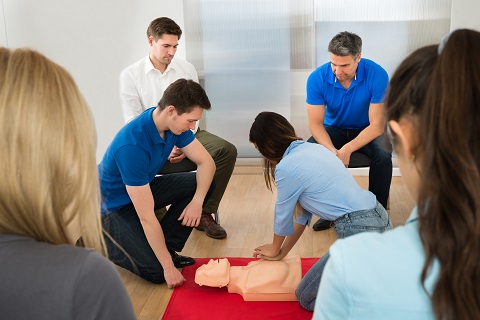 If you run a business, there’s a chance your employees are required to be CPR certified in order to maintain your license, their licenses and legal compliance.
If you run a business, there’s a chance your employees are required to be CPR certified in order to maintain your license, their licenses and legal compliance.
Examples include law enforcement, day care providers, doctor’s offices and construction companies. Even if your company isn’t required to provide CPR training, it’s never a bad idea. Not only are courses affordable, corporate CPR training can be brought right to your brick-and-mortar business, minimizing your employee’s missed work time – and the results can save lives.
Am I required to provide workplace CPR classes?
Legal requirements vary from state-to-state, and across industries. When it comes to standard for first aid training in general OSHA states:
In the absence of an infirmary, clinic, or hospital in near proximity to the workplace which is used for the treatment of all injured employees, a person or persons shall be adequately trained to render first aid. Adequate first aid supplies shall be readily available.
The phrase, “…in near proximity to the workplace,” leaves much to translation. How near is near? How fast is fast enough? Is my idea of near the same as a courtroom’s idea of near should a life-altering accident or incident occur at my place of business?
If you run a business in the United States…
OSHA mandates certain employees and laborers hold CPR and/or first aid certifications. These include:
- Those who work in permit-required confined spaces
- Logging operations
- Electric power generation, transmission, and distribution
- Dive teams
Furthermore, all general industry and construction employers must have either an employee trained in CPR, or:
- The work site must be located within a three to four minute response time of a hospital, clinic or infirmary if the work site contains workplace hazards that could cause life threatening injuries
OR
- The work site must be located within a 15-minute response time of a hospital, clinic or infirmary if the work site does not contain workplace hazards that could cause life threatening injuries.
Once again, legal teams can run circles around the phrase, “workplace hazards that could cause life threatening injuries.” That could include ladders, staircases, sharp blades, forklifts and loading docs, slippery floors, etc.
Thus, certain states – or individual business owners – have taken it upon themselves to craft more specific criteria around which businesses or entities should receive formal workplace CPR classes.
If you own a business in Virginia or North Carolina…
If you’re a business owner in Virginia or North Carolina, legal compliance around workplace CPR training is more detailed.
After a comprehensive analysis of statewide EMT response times governing bodies of these state found that average response times in most cases did not meet criteria for the response times listed by OSHA. Or, legislators felt there was too much wiggle room for translation if and when a workplace injury or fatality resulted in a lawsuit.
With that information in mind, and after risk and benefit assessments, VA and NC now require some level of CPR, AED and/or first aid training for the following employees:
- Hospital and medical personnel, including lab technicians and office personnel who work in a hospital or medical setting.
- Law enforcement, firefighters and EMT or first responders. This might also include front house staff of these entities in case a civilian enters the building in some sort of physical distress.
- Dentists and dental assistants.
- Flight attendants
- Jail and prison personnel
- Those who work with children, including teachers, school personnel, coaches, daycare workers, nannies and so on.
- Pool and beach lifeguards
Failure to comply with regulations could cost your business – or its employees, a license to practice or perform their job responsibilities. You may find consideration of OSHA regulations and statewide amendments lead to a restructuring of your company’s first-aid program.
Onsite CPR Training is an effective and affordable option
While your company’s willingness to reimburse employees or cover the cost for their CPR, AED and/or first aid certification is well-intentioned, it leads to extra costs in the end. Lost work time, transportation, meal credits and adding “one more thing” to a busy’ employee’s To-Do list can impede the process. Plus, who’s taking the time out to track certifications, renewal deadlines and expiration dates? That becomes another time and labor consumptive task.
OSHA also recommends,”Employers should make an effort to obtain estimates of EMS response times for all permanent and temporary locations and for all times of the day and night at which they have workers on duty, and they should use that information when planning their first-aid program.” There’s another time-consumptive effort to contend with.
Onsite, Corporate CPR training offers an affordable and effective solution. In just a few hours, employees can be brought into compliance and there’s no need to worry about emergency response times, expiration dates or renewals. One session, scheduled every year, ensures your company and its employees are covered.
Learn More About Workplace CPR Training
